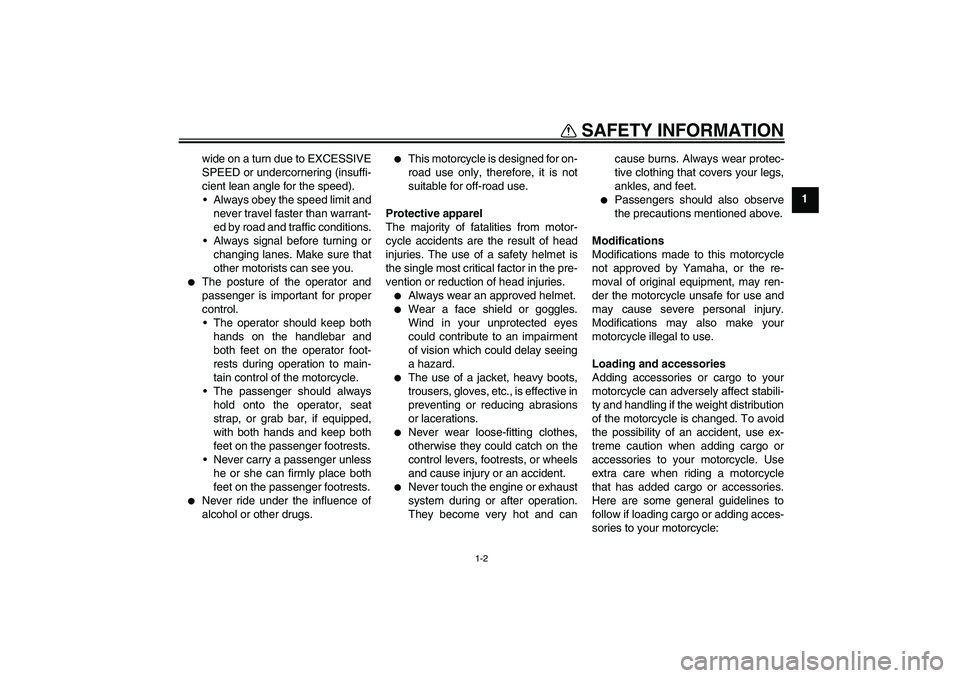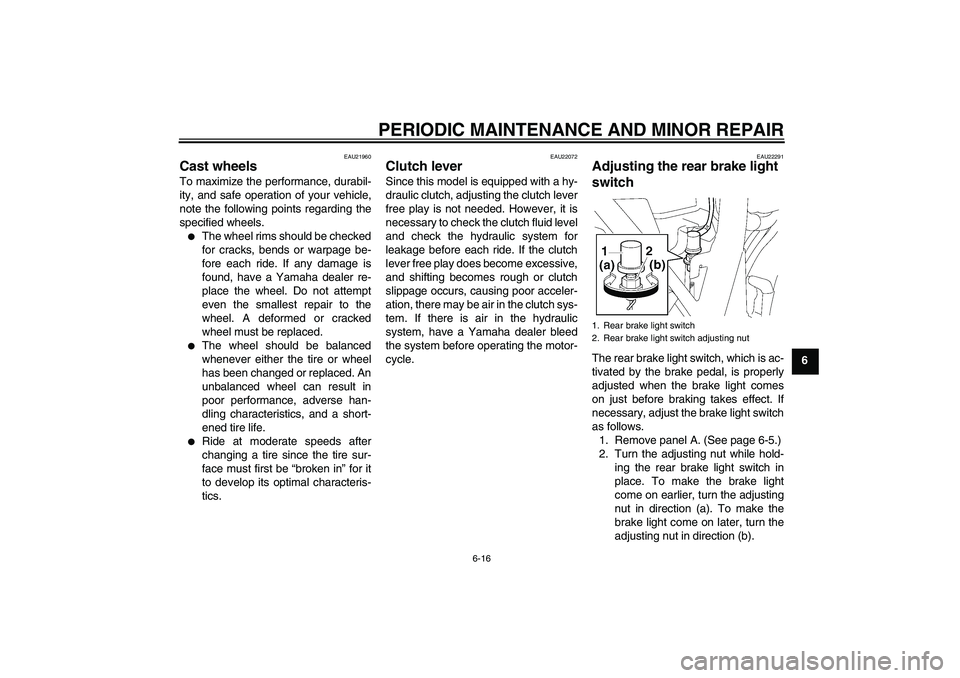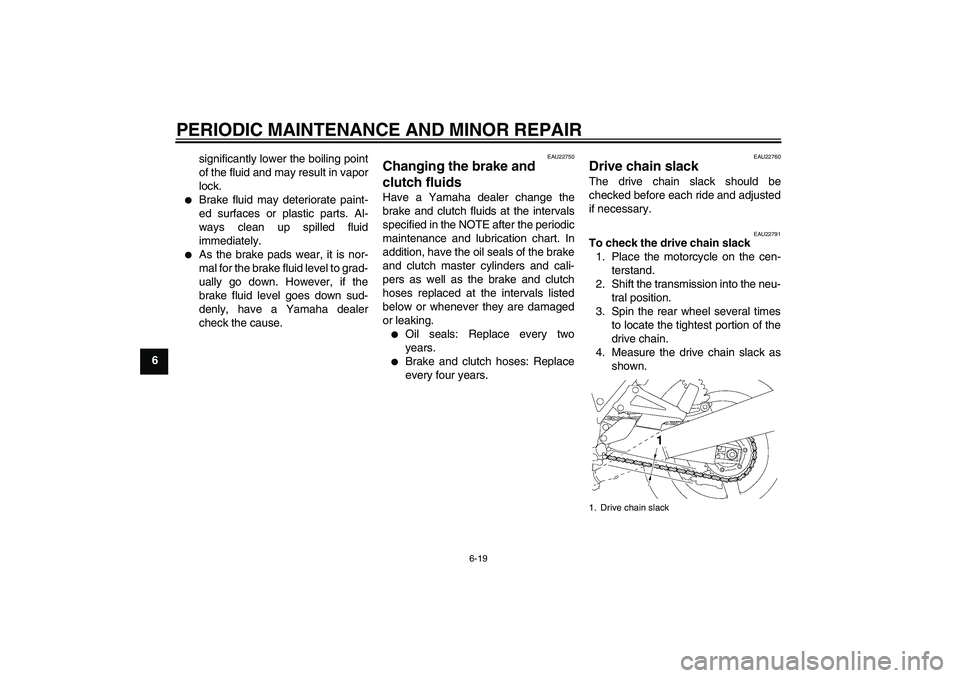Page 9 of 90

SAFETY INFORMATION
1-2
1 wide on a turn due to EXCESSIVE
SPEED or undercornering (insuffi-
cient lean angle for the speed).
Always obey the speed limit and
never travel faster than warrant-
ed by road and traffic conditions.
Always signal before turning or
changing lanes. Make sure that
other motorists can see you.
�
The posture of the operator and
passenger is important for proper
control.
The operator should keep both
hands on the handlebar and
both feet on the operator foot-
rests during operation to main-
tain control of the motorcycle.
The passenger should always
hold onto the operator, seat
strap, or grab bar, if equipped,
with both hands and keep both
feet on the passenger footrests.
Never carry a passenger unless
he or she can firmly place both
feet on the passenger footrests.
�
Never ride under the influence of
alcohol or other drugs.
�
This motorcycle is designed for on-
road use only, therefore, it is not
suitable for off-road use.
Protective apparel
The majority of fatalities from motor-
cycle accidents are the result of head
injuries. The use of a safety helmet is
the single most critical factor in the pre-
vention or reduction of head injuries.
�
Always wear an approved helmet.
�
Wear a face shield or goggles.
Wind in your unprotected eyes
could contribute to an impairment
of vision which could delay seeing
a hazard.
�
The use of a jacket, heavy boots,
trousers, gloves, etc., is effective in
preventing or reducing abrasions
or lacerations.
�
Never wear loose-fitting clothes,
otherwise they could catch on the
control levers, footrests, or wheels
and cause injury or an accident.
�
Never touch the engine or exhaust
system during or after operation.
They become very hot and cancause burns. Always wear protec-
tive clothing that covers your legs,
ankles, and feet.
�
Passengers should also observe
the precautions mentioned above.
Modifications
Modifications made to this motorcycle
not approved by Yamaha, or the re-
moval of original equipment, may ren-
der the motorcycle unsafe for use and
may cause severe personal injury.
Modifications may also make your
motorcycle illegal to use.
Loading and accessories
Adding accessories or cargo to your
motorcycle can adversely affect stabili-
ty and handling if the weight distribution
of the motorcycle is changed. To avoid
the possibility of an accident, use ex-
treme caution when adding cargo or
accessories to your motorcycle. Use
extra care when riding a motorcycle
that has added cargo or accessories.
Here are some general guidelines to
follow if loading cargo or adding acces-
sories to your motorcycle:
U5WME3E0.book Page 2 Thursday, August 4, 2005 8:48 AM
Page 57 of 90

PERIODIC MAINTENANCE AND MINOR REPAIR
6-16
6
EAU21960
Cast wheels To maximize the performance, durabil-
ity, and safe operation of your vehicle,
note the following points regarding the
specified wheels.�
The wheel rims should be checked
for cracks, bends or warpage be-
fore each ride. If any damage is
found, have a Yamaha dealer re-
place the wheel. Do not attempt
even the smallest repair to the
wheel. A deformed or cracked
wheel must be replaced.
�
The wheel should be balanced
whenever either the tire or wheel
has been changed or replaced. An
unbalanced wheel can result in
poor performance, adverse han-
dling characteristics, and a short-
ened tire life.
�
Ride at moderate speeds after
changing a tire since the tire sur-
face must first be “broken in” for it
to develop its optimal characteris-
tics.
EAU22072
Clutch lever Since this model is equipped with a hy-
draulic clutch, adjusting the clutch lever
free play is not needed. However, it is
necessary to check the clutch fluid level
and check the hydraulic system for
leakage before each ride. If the clutch
lever free play does become excessive,
and shifting becomes rough or clutch
slippage occurs, causing poor acceler-
ation, there may be air in the clutch sys-
tem. If there is air in the hydraulic
system, have a Yamaha dealer bleed
the system before operating the motor-
cycle.
EAU22291
Adjusting the rear brake light
switch The rear brake light switch, which is ac-
tivated by the brake pedal, is properly
adjusted when the brake light comes
on just before braking takes effect. If
necessary, adjust the brake light switch
as follows.
1. Remove panel A. (See page 6-5.)
2. Turn the adjusting nut while hold-
ing the rear brake light switch in
place. To make the brake light
come on earlier, turn the adjusting
nut in direction (a). To make the
brake light come on later, turn the
adjusting nut in direction (b).1. Rear brake light switch
2. Rear brake light switch adjusting nut
U5WME3E0.book Page 16 Thursday, August 4, 2005 8:48 AM
Page 60 of 90

PERIODIC MAINTENANCE AND MINOR REPAIR
6-19
6significantly lower the boiling point
of the fluid and may result in vapor
lock.
�
Brake fluid may deteriorate paint-
ed surfaces or plastic parts. Al-
ways clean up spilled fluid
immediately.
�
As the brake pads wear, it is nor-
mal for the brake fluid level to grad-
ually go down. However, if the
brake fluid level goes down sud-
denly, have a Yamaha dealer
check the cause.
EAU22750
Changing the brake and
clutch fluids Have a Yamaha dealer change the
brake and clutch fluids at the intervals
specified in the NOTE after the periodic
maintenance and lubrication chart. In
addition, have the oil seals of the brake
and clutch master cylinders and cali-
pers as well as the brake and clutch
hoses replaced at the intervals listed
below or whenever they are damaged
or leaking.�
Oil seals: Replace every two
years.
�
Brake and clutch hoses: Replace
every four years.
EAU22760
Drive chain slack The drive chain slack should be
checked before each ride and adjusted
if necessary.
EAU22791
To check the drive chain slack
1. Place the motorcycle on the cen-
terstand.
2. Shift the transmission into the neu-
tral position.
3. Spin the rear wheel several times
to locate the tightest portion of the
drive chain.
4. Measure the drive chain slack as
shown.1. Drive chain slack
U5WME3E0.book Page 19 Thursday, August 4, 2005 8:48 AM